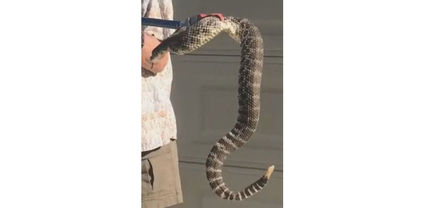The snake guys – and one snake gal
September 1, 2018
If you encounter a rattlesnake in Bear Valley Springs, who-ya-gonna-call?–ya call the snake guys–or the one snake gal. In any case, these six volunteers will take that call, ask you to keep your eye on the viper and hot-foot it to where you are, capture the rattler and then, a little later, relocate it.
"We definitely don't want you to kill the rattler," Mike Kemp, a snake guy and retired educator, said at a recent presentation. "They're just too beneficial to us. They eat so many things that can harm us."
Mice particularly are the source of the Hantavirus which harms heart, lungs, and kidneys and can be fatal.
"You also don't want to be bitten by a rattler. The intense pain is the least of your concerns. One of the last victims of snake bite in Bear Valley Springs survived after being in the hospital for over three weeks, running up a bill of over $1.4 million dollars," he said.
So what are these snakes we don't want to kill, and want to be able to identify quickly enough to avoid?
"In Bear Valley Springs we only have one type of rattlesnake, the Northern Pacific Rattlesnake. They come in green, brown and very dark, nearly black," said Kemp.
But it doesn't really matter the color, the clue to IDing them is their triangular, viper's head and their insistent, menacing rattle.
"If you're gardening, or taking a walk, and suddenly hear what might be a very fast sprinkler system going off, quickly withdraw your hands, take a step back and look around very carefully. Danger is near," he said.
The instant you see the viper, get away from it and make the call.
If you're in Mojave, as well as other parts of the Southwestern U.S. and Northern Mexico deserts, you have the Mojave Rattlesnake to watch out for. Locals call it the "Mojave Green," but it can come in other colors. In other parts of California you might run into the Eastern Pacific Rattlesnake and the Western Diamondback. No matter where you are, though, the message is pretty much the same. You don't want to get bit so stay watchful.
But as is true with many dangers in life, an ounce of prevention is worth a pound of cure. You definitely want to make your property, wherever you live, as rattlesnake unfriendly as you can. Here are a few tips to do that.
If you have thick bushes near your house, trim them way back or get rid of them altogether. Rattlers like to avoid the hot sun by slithering into the shade those bushes offer. Trim and prune plants near the house so that you can see the earth beneath them. Take away their hiding places and shade. Outdoor stairs also offer shade and hiding places. Enclose them if you can.
"And for heaven's sake, don't leave your garage door open. If a rattler gets into your garage it is terribly dangerous," said Mike Kemp.
And doubly so if it gets into your house.
"Don't leave doors open. If your pet needs to go out, take him out on a leash. We've had to get several rattlers out from under and behind sofas. Never fun," he said.
If you're outside where snakes might be, wear high top shoes.
"When a rattler strikes, he strikes straight out, not up. So high tops will usually protect you," Kemp said.
But what about pets, particularly dogs?
"Get your dog an anti-venom vaccine shot. They're not expensive and they really work. I've responded to calls where the dog's been bitten and because he's had the anti-venom vaccine shot beforehand he didn't need any additional medication to ward off the snakebite," said Kemp.
But whether your pet's had the shot or not, if bit, keep the animal calm, give him a tablet of Benadryl at 1 mg per pound (not liquid Benadryl by mouth), and immediately get the pet to the vet. Don't wait for symptoms to appear.
If a human is bitten, you and the victim stay calm. Keep the victim still as you prepare to treat the victim for shock. Remove the victim's jewelry, watches, bracelets, anything constrictive, while you keep the bite area clean and completely immobilized if possible. Keep the victim's airway clear and open and if the victim is conscious, administer fluids, preferably water. Suction on the wound is of little use for rattlesnake bite. (If you have an extractor type device designed for venomous bites it may be beneficial for bee stings.) Therefore, do nothing to the wound, but as soon as you can, immediately if possible, call 911 and get the victim to the nearest hospital.
All that said, here are some things to remember. Rattlesnakes are the only dangerously venomous snakes in California, all others are not. If you come upon a dead rattlesnake, avoid it. Many people have been bitten by the dead snake's reflex action. If you come upon one, cut the head off and bury it. Baby rattlers are not more venomous, but from birth they do have venom, and baby or not, they don't have to rattle before striking nor do they have to be coiled. They can strike from any position. Finally, a rattler will not "attack" you. It is more afraid of you than you are of it. If it has an escape route, it will take it. And, in all probability, you are faster than any rattlesnake.
If you want to know more about The Snake Guys visit their Facebook page: Bear Valley Spring Snake Guys.





